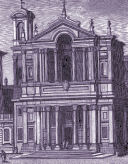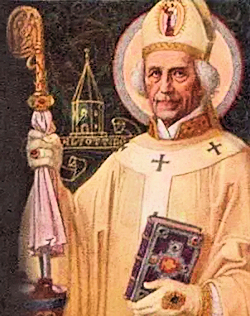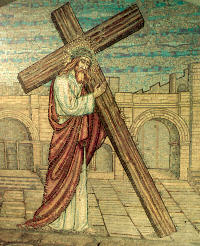Lent: March 27th
Tuesday of the Fifth Week of Lent
Other Commemorations: St. Rupert, Bishop (RM)
» Enjoy our Liturgical Seasons series of e-books!
"When you have lifted up the Son of Man, then you will know that I am he." All the world's hatred and suffering are the results of sin, original or personal. To restore all things to love and order and joy, Jesus atoned for sin by His death and won the grace that effects forgiveness. His indwelling life is the basic sanctity of Christians, to be developed into acquired splendor. — Daily Missal of the Mystical Body

The Station in Rome was formerly the church of the martyr St. Cyriacus, and as such it is still given in the Roman missal; but this holy sanctuary having been destroyed, and the relics of the holy deacon translated to the church of St. Mary in Via lata, it is here that the Station is now held.
Meditation
Christ on the Cross is the salvation of the human race, the remedy for all our ills. He went voluntarily to Calvary, so that whosoever believes may have eternal life, so that he might draw all men to himself.
In no matter what age they attack God's people as they travel towards the promised land of Heaven, the serpents and the poison are much the same: selfishness, sensuality, doctrinal errors and confusion, laziness, envy, slander, calumny ... The grace we receive in Baptism, which is intended to reach its full development, is threatened by the same enemies as they always have been. In all ages we can perceive the wounds of original sin and of personal sins.
We Christians must seek the remedy and the antidote — just as the Israelites bitten by the serpents in the wilderness did — in the only place that it is to be found: in Jesus Christ and in his saving doctrine. We must not cease from contemplating him raised above the earth on the Cross, if we truly want to reach the Promised Land that comes at the end of this short journey. That is all this life really is. And as we do not want to reach our destination alone, we will strive to get many others to look at Jesus, in whom is salvation. Look at Jesus. Place before your eyes his most Holy Humanity, contemplate him in the Mysteries of the Holy Rosary, in the Way of the Cross, in the scenes that the Gospels narrate for us, or in the Tabernacle. Only if we have great piety will we be strong against the harassment of a world which seems to want to separate itself more and more from God, dragging with it anyone who is not on firm and sure ground.
We cannot turn our gaze away from God, because we see the havoc that the enemy wreaks around us every day. By himself, nobody is immune. 'Vultum tuum, Domine, requiran': Thy face, Lord do I seek hide not thy face from me. We must grow in fortitude through our loving and constant conversation with Jesus, through prayer, through keeping presence of God throughout the day, and through our visits to the Blessed Sacrament. We must remember, too that Our Lord, Jesus, is not only the remedy for our weakness; He is also our Love. — In Conversation with God, Francis Fernandez
St. Rupert of Salzburg
 St. Rupert was the first bishop of Salzburg, who, in some legends, is credited with giving the city its name.
St. Rupert was the first bishop of Salzburg, who, in some legends, is credited with giving the city its name.
Rupert was born in the late seventh century, to a part of the French imperial family. Little is known about his early life, but, like many sons of noblemen, entered the clergy. Rupert was elected bishop of Worms, a German city that was an important seat of power in the Carolingian dynasty.
At first, Rupert's flock welcomed his presence as a caring and faithful bishop. All too soon, however, the relationship between Rupert and the people of Worms soured. Conveniently, a Bavarian Duke, Theodo, asked for Rupert to come south to his palace at Regensburg to come spread Christianity to the diverse tribes he ruled over in Bavaria.
Rupert is often credited with baptizing Theodo, and officially welcoming him into the Church, as the seventeenth-century painting to the left depicts. And with Theodo's blessing, he began his missionary work among the Bavarian tribes.
Rupert found that Bavaria was still, in many ways, truly a wilderness with lots of outbreaks of violence. Thus, Rupert traveled to an old ruined Roman city and renamed it "Salzburg." Rupert founded and rebuilt several different monasteries in the area and lay the foundations of the Salzburg Cathedral. Where, a little over a thousand years later, Wolfgang Amadeus Mozart was baptized.
Rupert died in 710, and there's some dispute whether he had returned back to Worms at the time of his death or whether he died in Salzburg. His successor, Bishop Vergilius of Salzburg, interred his remains in the newly-finished Salzburg Cathedral in 774.
Rupert is known as the "Apostle to the Bavarians" and is a patron saint of Salzburg, Austria, and salt miners.
—Excerpted from Faith ND
Patronage: city of Salzburg, Austria; province of Salzburg, Austria; archdiocese of Salzburg; salt miners
Symbols and Representation: man holding a container of salt (refers to Salzburg and the salt mining there); wearing clerical clothes including mitre; holding a crosier
Highlights and Things to Do:
- Read more about St. Rupert:
- Read about St. Rupert's Fair, the biggest traditional fair in Europe.
- See the Stift St. Peter -- St. Peter's Abby that St. Rupert restored and lived.
- St. Rupert's remains are located at the Salzburg Cathedral at the Volksaltar.






